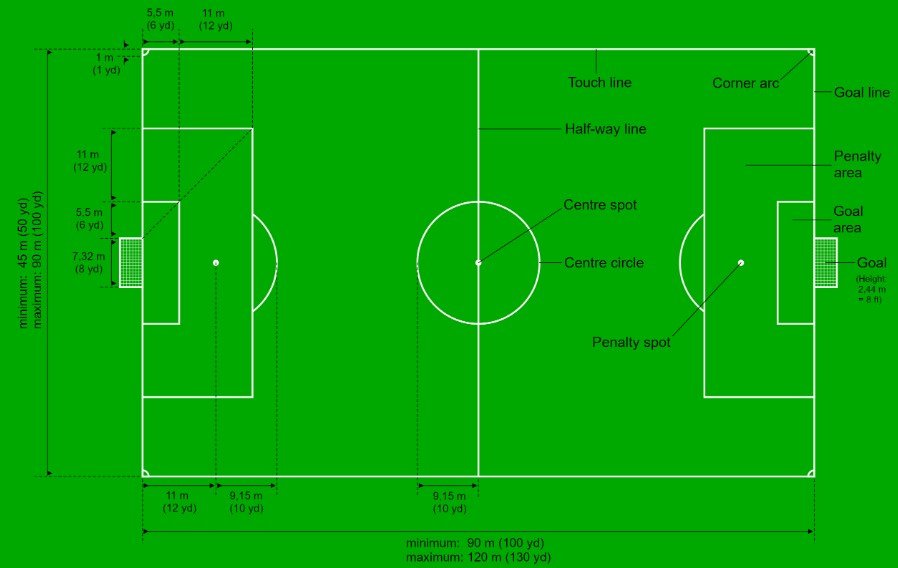A standard soccer field is typically around 360 feet in length and 225 feet in width. Soccer fields vary in size, but the standard dimensions are commonly used worldwide.
Soccer, a beloved sport played on a rectangular field, requires specific measurements for optimal gameplay. A regulation soccer field typically spans 360 feet in length and 225 feet in width. These dimensions provide ample space for players to showcase their skills, maneuver the ball, and score goals.
Understanding the size of a soccer field is essential for players, coaches, and fans alike to appreciate the game’s dynamics and strategies. Whether in a local park or a professional stadium, the soccer field’s dimensions play a crucial role in shaping the sport’s exhilarating experience.
A Soccer Field

Table of Contents
Importance Of Soccer Field Measurements
Soccer field size in meters is crucial for fair play and strategy.
How many feet a soccer field is in meters determines gameplay dynamics.
How many yards does a soccer field impact high school matches?
Dimensions of A Standard Soccer Field
A standard soccer field is around 100–130 yards in length and 50–100 yards in width, with the length always being greater than the width. In feet, this translates to 300–400 feet long and 150–300 feet wide.
Soccer is a popular sport worldwide, played by millions of people of all ages and skill levels. One of the key aspects of the game is the soccer field, which has specific dimensions that must be adhered to for official play. The standard soccer field dimensions are 100–130 yards in length and 50–100 yards in width. The length and width of the field can vary depending on the level of play, but the general dimensions remain the same.
Length Of A Soccer Field
The length of a standard soccer field ranges from 100 to 130 yards or 300 to 390 feet. This length includes the end zones, which are usually 10 yards, each. The length of the field can vary depending on the level of play, with professional fields typically being on the longer end of the spectrum. The length of the field is an important factor in the game, as it determines the amount of space players have to move and make plays.
Width Of A Soccer Field
The width of a standard soccer field ranges from 50 to 100 yards, or 150 to 300 feet. The width of the field can also vary depending on the level of play, with professional fields typically being on the wider end of the spectrum. The width of the field is important in the game, as it determines the amount of space players have to make plays and move the ball down the field.
Soccer Field Dimensions At Different Levels of Play
The dimensions of a soccer field can vary depending on the level of play. Here are some common soccer field dimensions:
- Professional soccer field: 110–120 yards in length, 70–80 yards in width
- High school soccer field: 100–120 yards in length, 50–100 yards in width
- Youth soccer field: 50–80 yards in length, 30–50 yards in width
It’s important to note that these are just general guidelines, and the actual dimensions of a soccer field can vary depending on the specific facility. However, regardless of the dimensions, the key elements of a soccer field remain the same: the goalposts, the midfield line, and the penalty areas.

Comparison With Other Sports Fields
A soccer field measures around 100–130 yards long and 50–100 yards wide, varying between professional and youth games. Comparing it with other sports fields, a soccer field is generally larger than a basketball court but smaller than an American football field.
Soccer Field Vs. Football Field
When comparing a soccer field to a football field, it’s important to note that a standard soccer field measures approximately 100–130 yards in length and 50–100 yards in width, totaling between 5,000 and 13,000 square yards. In contrast, a standard American football field measures 120 yards in length and 53.3 yards in width, totaling 6,400 square yards.
Soccer Field Vs. Rugby Field
Comparing a soccer field to a rugby field reveals that a rugby field is similar in size to a soccer field. Both sports share a similar field length of 100–130 yards, but rugby fields can vary in width, typically falling within the range of 50–70 yards, resulting in a similar area as a soccer field.
Regulations And Guidelines
A standard soccer field is typically 100–130 yards in length and 50–100 yards in width, with the goalposts located at each end. The regulation size can vary for different age groups and levels of play, but generally, a soccer field is around 1.
32 acres in size.
Fifa Regulations
FIFA sets the standard dimensions for soccer fields worldwide.
Youth Soccer Field Size Guidelines
For youth soccer fields, there are specific guidelines to ensure a suitable playing area.
Impact of Field Size on Gameplay
The impact of field size on gameplay in soccer can significantly affect player strategies and overall performance. Understanding the dimensions of a soccer field, typically measuring around 100–130 yards in length and 50–100 yards in width, is crucial for players to adapt their tactics effectively.
The size of the field directly influences player movement, passing accuracy, and overall game dynamics.
Impact of Field Size on Gameplay The dimensions of a soccer field have a significant impact on gameplay, influencing strategies and player performance. Understanding the influence of field size is crucial for both players and coaches, as it directly affects the dynamics and tactics employed during a match. Influence on Strategy The size of the soccer field directly influences the strategic approach of teams. Larger fields provide more space for players to maneuver and spread out, encouraging a possession-oriented playing style. On the other hand, smaller fields prompt teams to play a more compact and defensive game, focusing on quick transitions and tight defensive formations.
Historical Evolution of Soccer Field Dimensions
Soccer, also known as football in many countries, has a rich history that dates back centuries. As the sport evolved, so did the dimensions of the soccer field. Understanding the historical evolution of soccer field dimensions provides insight into how the game has developed over time.
Changes Over Time
The dimensions of soccer fields have undergone various changes throughout history. From the early days of the sport to the modern era, the size of soccer fields has seen several alterations to accommodate the changing dynamics of the game.
Factors Influencing Alterations
Several factors have influenced the alterations in soccer field dimensions. These include advancements in player tactics, modifications to in-game regulations, and the need to enhance the overall playing experience for both players and spectators.
Notable Soccer Fields Worldwide
Iconic soccer stadiums hold a special place in the hearts of fans worldwide. From the historic Camp Nou in Barcelona to the legendary Maracanã in Rio de Janeiro, these stadiums have witnessed countless memorable moments.
Other notable stadiums include:
- Wembley Stadium in London
- Santiago Bernabéu in Madrid
- Allianz Arena in Munich
Some soccer fields stand out for their unique designs and features, adding to the excitement of the game. The field at The Float at Marina Bay in Singapore, which floats on water, offers a breathtaking backdrop for matches.

Future Trends in Soccer Field Design
In the rapidly evolving world of soccer, the design and layout of soccer fields are continuously adapting to meet the demands of the modern game. From technological advancements to environmental considerations, these trends are shaping the future of soccer field design.
Technological Advancements
With advancements in technology, soccer fields are now incorporating innovative features to enhance player performance and the spectator experience. This includes the use of state-of-the-art turf systems that offer improved shock absorption, traction, and durability. Furthermore, the integration of sensor-based technologies allows for real-time tracking of player movements and performance metrics, providing valuable data for coaches and players to optimize their strategies and training regimens.
Environmental Considerations
Environmental sustainability is becoming increasingly important in soccer field design. The use of eco-friendly materials, such as recycled infill for artificial turf, is gaining traction to minimize the environmental impact of field construction and maintenance. Additionally, the implementation of sustainable irrigation systems and energy-efficient lighting solutions not only reduces operational costs but also promotes eco-conscious practices within the soccer community.
Conclusion
The dimensions of a soccer field play a crucial role in the game. Understanding the standard measurements of a soccer field, including its length and width, ensures fair play and a level playing field for all. Whether it’s for professional or youth games, knowing the size of a soccer field is essential for players, coaches, and fans alike.

